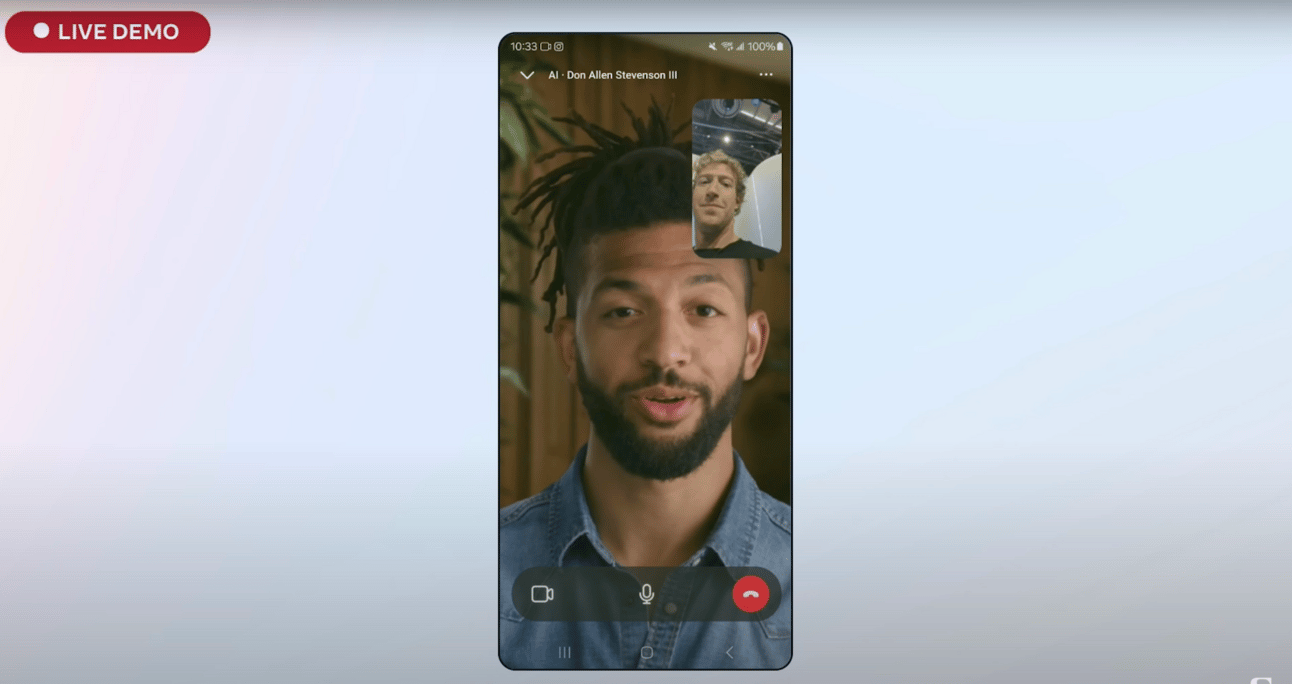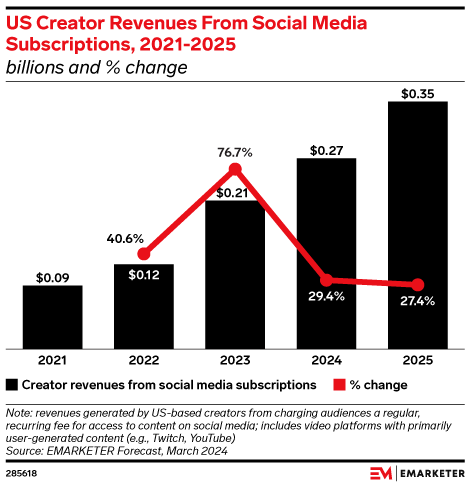
Meta / Meta Connect 2024
Last week, I attended my first INBOUND conference, thanks to HubSpot Creators (hence, no newsletter that week). But look out for a bonus edition next week, where I'll share my experience of being on the creator side of an IRL activation, along with key takeaways for brands and influencer marketers to incorporate into their own in-person creator activations.
TODAY’S EDITION
Meta announces new creator tools at its annual developer conference, including AI-powered photo editing, language dubbing for Reels, and realistic video avatars.
TikTok aims to penetrate Google’s ad business by introducing Search Ad Campaigns, specifically targeting Gen Z search behavior.
Pinterest expands its Gen Z-loving, interactive format, Collages, with new creation and sharing functionalities.
As subscription-based revenue for creators rises, TikTok unveils updates to its Subscriptions feature to help creators diversify their revenue streams.
LinkedIn bids farewell to its Top Voice Community badges, which reward users for their contributions to Collaborative Articles.
If you’re enjoying the newsletter and finding it valuable, I’d love to hear from you! You can also support it via Buy Me A Coffee.
DEEP DIVE
Meta Connect 2024: Key Creator Updates—AI Photo Editing, Video Dubbing, Realistic Avatars, & Immersive Content

Meta / Meta AI Background
Meta held its annual developer event, Meta Connect 2024, this week, announcing several updates across AI, VR, and AR. Along with unveiling new devices like Meta Quest 3S, upgrades to Ray-Ban Meta Glasses, and the advanced (though not yet ready for consumers) augmented reality glasses, Orion, the company also shared updates that will be relevant to creators of all sizes, primarily around Meta AI.
Here’s a look at four of the most notable updates, why they matter, and what they mean for creators:
Photos in Meta AI

Meta / Photos in Meta AI
A new feature within the AI assistant allows creators to share photos and ask questions, such as identifying what’s in the photo. Additionally, creators can edit images by instructing the AI to add, change, or remove components. There is also a background feature that will automatically generate backgrounds when creators share a feed post to their Stories.
Why It Matters: This will help creators in several ways, from managing everyday tasks that save time to providing creative support for content creation. The ability to quickly edit photos with prompts gives creators greater flexibility and efficiency when it comes to bringing both new and existing content to life.
Meta AI Translations

The company is currently testing a translation tool that will automatically translate the audio of Reels into other languages, starting with English and Spanish. It includes dubbing and lip-syncing technology that mimics the speaker’s voice in another language while syncing their lips to match.
Why It Matters: In a move similar to YouTube, creators will be able to overcome language barriers, enabling them to reach larger global audiences without extensive time and effort in translation and production. This feature benefits viewers as well, allowing them to discover and engage with content creators who speak different languages.
Meta Creator AI Video Avatars

Meta / Creator AI Video Avatars
The ability for creators to generate AI-driven digital avatars of themselves is also in development. At the event, the company demoed an AI version of Don Allen Stevenson III, a digital avatar that not only looked like him but also responded and interacted like him. This is expected to be available next year in the US.
Why It Matters: Following the path of TikTok and other AI-driven startups, Meta aims to help creators scale their presence through AI. Building on the launch of its AI chatbots for creators, the company is advancing with lifelike digital avatars that mimic their human counterparts. Although there has been considerable buzz around digital avatars, large-scale adoption hasn’t yet taken off—especially among long-tail creators. With Meta’s massive user base, it could help more creators take advantage of this technology.
Redesigned Facebook & Instagram Apps for Quest

Meta / Instagram & Facebook Quest Apps
The Facebook and Instagram apps for the Meta Quest headsets have been redesigned, introducing a more immersive interface. The updates include improved navigation and the addition of dynamic spartial audio for panels displaying 2D content.
Why It Matters: Meta is now upgrading the overall experience of its core apps for mixed reality. While the company hasn’t prioritized bringing its platforms to TV screens like YouTube and TikTok, it is shifting towards larger screens in mixed reality via its VR headsets. Users will be able to consume creator content in a more immersive way. This also connects the company’s family of apps and operating systems, creating a more integrated ecosystem.
The Bigger Picture
With these new features, creators will be able to scale their businesses and maximize their creativity. They gain new ways to streamline content creation with AI-powered editing while reaching broader audiences through improved accessibility via language dubbing and emerging technologies like realistic avatars.
NEWS, TRENDS & INSIGHTS
TikTok
TikTok Introduces Search Ads Campaigns

TikTok / Search Ads Campaign
TikTok introduced Search Ads Campaign, a new feature in TikTok Ads Manager that enables advertisers to serve keyword-based ads on the platform’s search results page. With objectives focused on driving traffic and web conversions, advertisers gain access to enhanced features and targeting capabilities, including keyword suggestions that provide the monthly search volume for individual keywords.

TikTok / Search Ads
Initial testing showed that advertisers running Search Ads alongside In-Feed Ads experienced a 20% increase in conversions.
Why It Matters: TikTok’s latest ad solution taps into evolving search behavior, with over 50% of people now preferring to research products via video and social platforms rather than traditional search engines. On TikTok, 57% of users utilize its search functionality, and nearly a quarter search for something within 30 seconds of opening the app.
Building on the earlier Search Ads Toggle feature, advertisers can now run dedicated search ad campaigns, giving them control over keywords and audience targeting. This allows them to reach high-intent users actively searching for terms related to their brand, products, or services—especially valuable as the holiday season approaches.
To maximize performance, brands should incorporate creator content into these campaigns, ensuring ads blend seamlessly with the organic content searchers expect.
TikTok’s Search Ads Campaign is a direct competitor to Google’s paid search ads. For brands prioritizing TikTok as a key channel, this offers a reason to shift part of their search ad budget to TikTok’s more robust solution.
While TikTok has a long way to go before challenging Google’s dominance, the platform is positioning itself to compete in certain search categories. According to a survey, Gen Z tends to use TikTok for searches related to gift ideas, beauty, wellness, fitness, recipes, and meal inspiration, in contrast to using Google for these topics.

eMarketer
TikTok Revamps Subscriptions to Expand Revenue Options for Creators

TikTok / Subscriptions
TikTok is expanding its updated Subscription feature to more eligible creators in select regions. Earlier this year, TikTok announced that this feature would also be available to non-LIVE creators. The update allows creators to offer three subscription tiers, each including perks such as:
Private Communication Channels: Access to Sub Space, chats, comments, and messages.
Exclusive Content: Available across videos, LIVEs, and Notes.
Community Identifiers: Unique stickers for LIVEs and badges next to subscribers' profiles and comments.
Custom Perks: Access to personalized perks like performance requests, Discord roles, shout-outs, and LIVE topics.
Why It Matters: Direct-to-audience monetization is growing rapidly, with subscription-based earnings for U.S. creators projected to reach $350 million by 2025, a 27.4% year-over-year increase, according to eMarketer.

eMarketer
TikTok’s updated subscription feature helps creators diversify their revenue streams beyond brand deals and the Creator Rewards program. With flexible pricing and customizable perks, creators can tailor their tiers to meet their audience's expectations.
Other platforms, like Patreon, are also enhancing their subscription offerings. Patreon has introduced a new Autopilot feature that helps creators convert fans into paying subscribers by identifying free members most likely to upgrade and offering them discounts.
Pinterest Adds Collage Remixing & Sharing Features

Pinterest announced updates to Collages, its interactive Pin format:
Remixing: Users can now remix existing collages by adding text, drawings, or changing backgrounds, with the original collage and its creator tagged.
Sharing: Users can download and share collages as dynamic videos featuring themes like Timelapse on other social media platforms. Pinterest also plans to introduce direct integrations with these platforms.
Why It Matters: Collages have gained immense popularity among Gen Z, Pinterest’s fastest-growing demographic. Since the beginning of the year, there has been a 418% increase in collage creation as younger users embrace the format for self-expression, from mood boards to future planning.
The new remixing feature allows users to build on existing content, akin to remix capabilities found on Instagram, TikTok, and YouTube. Sharing options empower users to share their Collages across other social platforms, where content related to Pinterest Collages is already gaining traction. There are currently over 9.3 million TikTok videos on “Making Pinterest Collages.”
Together with Board Sharing, Pinterest is solidifying its position as both a creative tool and a platform for discovery, inspiration, and curation.
Collage content has quietly emerged as a significant trend across social media. Beyond Pinterest, apps like Landing and Verse focus on collage-based content, while Instagram and TikTok’s sister app, Lemon8, offer similar features. Even Amazon has started testing a collage tool for creator storefronts.

Stevie Starks / Amazon Storefronts Collage Tool
With collages appealing to Gen Z and their interactive shopping potential, two trends are likely to emerge: platforms like TikTok and YouTube may introduce similar features, and brands will create more collage content, either in-house or through creator partnerships.
LinkedIn Retires Top Community Voice Badges for Contributors of Collaborative Articles

LinkedIn / Community Top Voice Badge
LinkedIn is retiring its Top Community Voice badges—gold badges awarded to users who frequently contributed to Collaborative Articles. Unlike the invite-only, manually selected Top Voice badges (blue), these were automatically granted based on participation levels.
For current Top Community Voice badge holders, the badges will expire 60 days after being awarded, with all badges phased out by December 7, 2024.
Why It Matters: Although these badges were intended to encourage engagement, their automatic distribution—regardless of contribution quality—led to oversaturation, diminishing their value and effectively turning them into participation trophies.
With the badges being eliminated, it will be interesting to see whether participation in Collaborative Articles declines, as the badges seemed to incentivize some users to respond to the AI-powered prompts. Additionally, with LinkedIn recently opting all users into allowing the platform to train on its data, some have speculated that Collaborative Articles were a data play from the beginning, which may already be deterring some users from engaging with the feature.

LinkedIn / Generative AI Improvement Toggle
LinkedIn isn’t alone in utilizing gamified incentivization systems; other platforms, like TikTok, employ similar approaches to encourage specific actions for AR Effects. While these rewards can foster engagement, platforms must strike a balance between making them meaningful and avoiding oversaturation.
Share your thoughts and see how others are reacting to the removal of the badges in the comments of this post here.
THANK YOU
Thank you for reading! If you've enjoyed this, please consider sharing it with a colleague or friend. If you have any feedback, ideas, tips, or questions or would like to advertise in the newsletter or collaborate, please don't hesitate to reply to this email, reach out here, or send me a DM.
